Check out this video to learn more about the highly successful model David has infused into his planning process
In the realm of investment strategies, one of the more intriguing approaches is the endowment model, notably employed by large institutions like university endowments. This model, championed by figures like David Swensen of Yale University, offers unique insights for individual investors, especially those planning for retirement.
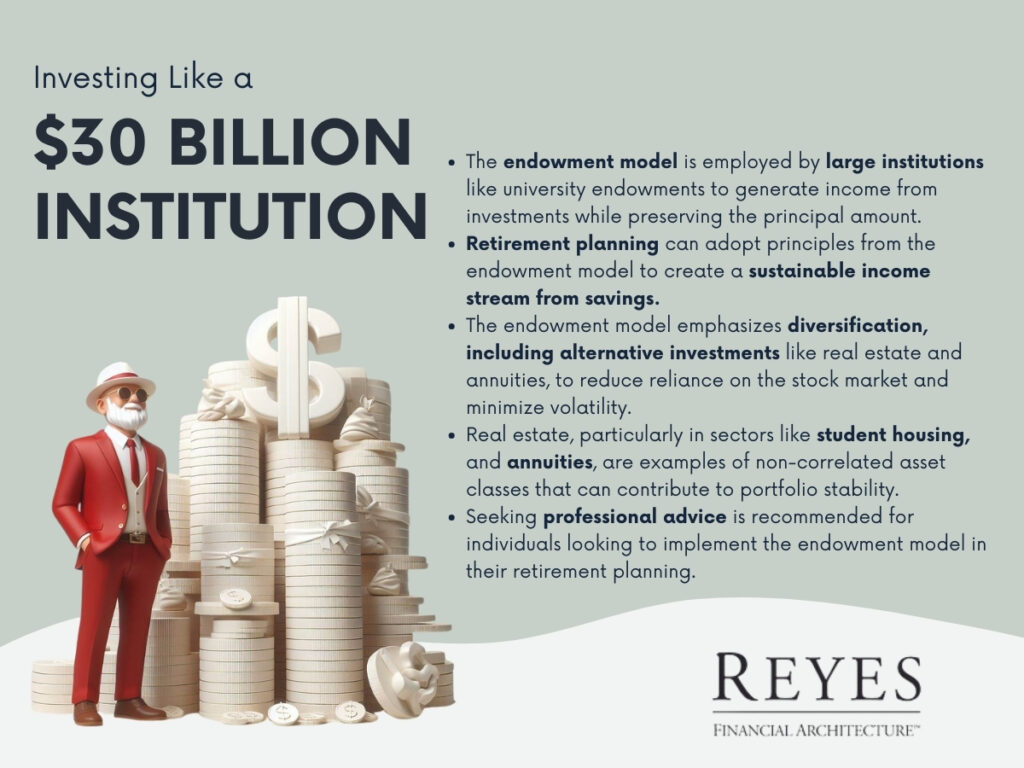
At its core, an endowment is a financial asset, like a fund, held by institutions such as universities. It’s made up of donations that are invested to generate income for the institution. The principal amount generally remains intact while the income supports various expenses.
The Yale endowment, under Swensen's management, became a hallmark of this approach. Yale’s strategy was not just successful but also revolutionary in how it diversified investments beyond the traditional stock and bond portfolio. This diversification aimed to achieve steady returns while minimizing risks.
Retirement planning can be akin to managing an endowment. In both cases, the goal is to create a sustainable income stream from a large pool of savings. The typical recommendation for endowment funds is to aim for a 5% annual distribution. This figure interestingly aligns with the retirement income strategies suggested by many financial planners.
However, a critical difference lies in the investment approach. Traditional retirement portfolios often focus heavily on stocks and bonds. In contrast, the endowment model advocates for a more diversified portfolio including alternative investments.
The endowment model’s success largely stems from its inclusion of alternative investments. These can range from private equity and hard assets like real estate to even more niche options like annuities. For instance, Yale’s portfolio in 2001 included a significant portion in hard assets, primarily real estate, alongside a smaller proportion in domestic and foreign equities.
This diversification strategy not only reduces reliance on the stock market but also potentially smoothens out returns, reducing volatility. The objective is to create a portfolio that can withstand market downturns better and provide more consistent returns over time.
Real estate, especially in sectors like student housing, is a prime example of an alternative investment that can offer stable returns. Properties near major universities, such as USC, Notre Dame, or Northwestern University, can provide a steady income stream, often with tax advantages.
Annuities are another diversifier in this model. While not directly linked to stock or bond markets, they can provide a steady income, adding another layer of stability to a retirement portfolio.
One of the key strengths of the endowment model is its use of non-correlated asset classes. Investments like real estate or annuities don’t necessarily move in tandem with the stock or bond markets. This non-correlation can significantly reduce the portfolio's overall risk.
For individual investors, adopting an endowment-like strategy means moving beyond the conventional wisdom of a stock-and-bond-dominated portfolio. It involves exploring and investing in a variety of asset classes. However, this approach requires careful planning and a thorough understanding of each investment type.
Given the complexity of this investment strategy, seeking professional advice is prudent. Financial advisors with experience in the endowment model can provide valuable insights and help tailor a portfolio that suits an individual’s retirement goals and risk tolerance.
The endowment model, inspired by the strategies of large institutions like Yale University, presents an innovative approach for individual investors, especially those in retirement planning.
Its focus on diversification across various asset classes aims to provide a balanced investment portfolio that can weather market volatility and generate sustainable income. While it may require stepping out of the traditional investment comfort zone, the potential for a more stable and robust retirement income is an enticing prospect for those willing to explore beyond stocks and bonds.
In recent times, the financial markets have been characterized by significant volatility and unpredictability, often leading investors to experience what is popularly known as the FOMO (Fear of Missing Out) Market. This term aptly encapsulates the anxiety and urgency that investors feel in the face of rapidly changing market conditions, driven by the fear of missing out on potential gains.
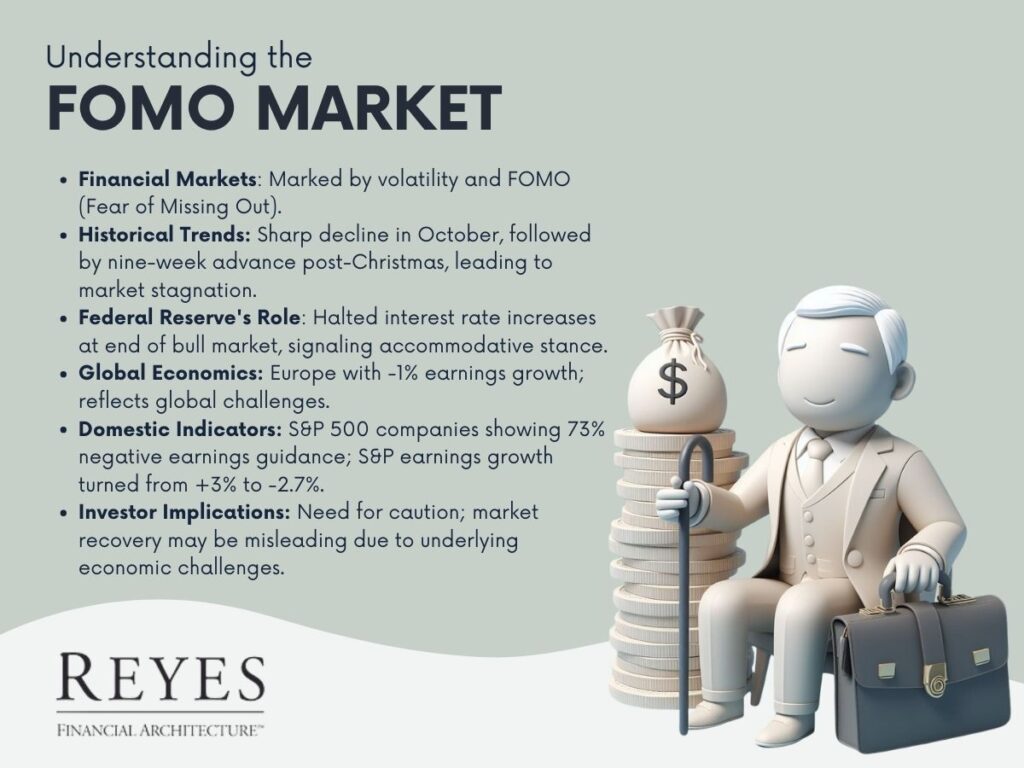
Historically, October of the previous year marked one of the worst performances since 1931, followed by a nine-week continuous advance in the market post-Christmas. This pattern of a sharp decline followed by a rapid ascent has essentially led to a stagnation in market progress over the past year and a half.
The last quarter of the year saw the market in a precarious position, facing challenges from various fronts. However, the Federal Reserve's intervention played a pivotal role in altering this trajectory. The Fed's decision to halt interest rate increases towards the end of a bull market was an unprecedented move, breaking away from traditional monetary policy patterns. This cessation is particularly notable as the market technically entered a bear phase, with a 20% drop from its peak.
The Federal Reserve's actions are crucial in understanding market dynamics. Typically, the Fed raises interest rates to curb inflation and stabilizes the economy, but in this case, they chose a different path. By not increasing rates, the Fed essentially signaled a more accommodative monetary stance, which historically tends to boost market confidence and investment.
Globally, Europe exhibited negative earnings growth in the last year, with a decline of about 1%. This is significant as it reflects broader economic challenges beyond the United States. In the domestic context, nearly all S&P 500 companies have reported their earnings, with a staggering 73% providing negative earnings guidance. This indicates a pessimistic outlook for the future, with expectations of performance being worse than the present.
The S&P earnings growth, which was estimated at 3% in December, has now turned negative, standing at -2.7%. This downturn is particularly stark, considering the record-high earnings growth witnessed in 2018.
These market conditions underscore the need for caution among investors. The rapid recovery of the markets from recent losses might create an illusion of stability and growth. However, the underlying economic indicators suggest otherwise. The volatility is likely to persist, and it's crucial for investors to be prepared for this uncertainty.
Investors are advised to develop a comprehensive understanding of the risks associated with their portfolios. This involves not only a keen awareness of market trends but also a thorough assessment of individual investment objectives, risk tolerance, and long-term financial goals.
In conclusion, navigating the FOMO Market requires a balanced approach, blending caution with opportunity. Understanding the broader economic context, staying informed, and aligning investment strategies with individual risk profiles are key to successfully managing investments in these volatile times. Investors should remain vigilant, adaptable, and informed to make the most out of the opportunities that arise, while safeguarding their investments against potential downturns
https://youtu.be/tYioyLxbNTI
Take a minute to watch this video for important information on long-term care, a topic everyone needs to be ahead of.
Long-term care (LTC) is a critical aspect of health and personal care that affects a significant portion of the population. Statistics indicate a high probability—around 70%—that an individual or their spouse will require long-term care at some point. This statistic underscores the importance of understanding what long-term care entails, its costs, and how to prepare for it.
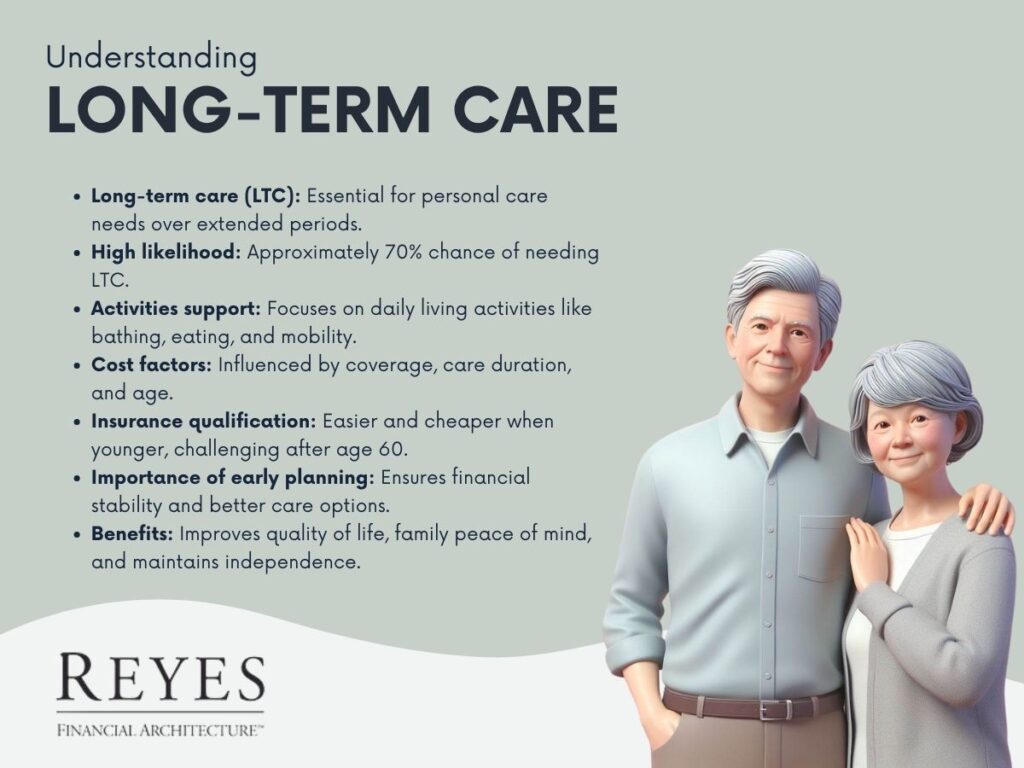
Long-term care refers to a variety of services and supports tailored to meet an individual’s personal care needs over an extended period. Contrary to common misconceptions, most long-term care is not medical in nature. Instead, it predominantly involves assistance with everyday activities crucial for daily living.
Activities of Daily Living, or ADLs, are fundamental tasks that most people perform daily without assistance. These include:
Instrumental Activities of Daily Living, or IADLs, are tasks that are somewhat more complex than ADLs and are essential for independent living. These include:
The cost of long-term care can vary significantly based on several factors:
The initial premium level for long-term care insurance tends to increase with the age of the applicant. Younger individuals typically face lower premiums, highlighting the advantage of planning for long-term care early.
Qualifying for long-term care insurance becomes more challenging with age. Statistics show that 1 in 4 applicants between the ages of 60 and 69 do not qualify for such insurance. This statistic is a stark reminder of the importance of early planning.
Given the high likelihood of needing long-term care and the associated challenges and costs, it is crucial to understand the options and prepare adequately. This preparation is not just a personal matter but also a significant consideration for families.
Understanding and preparing for long-term care is a critical aspect of life planning. Given the high probability of needing such care, it’s prudent to start planning early. This includes understanding what long-term care entails, evaluating insurance options, and considering personal and family needs. By taking proactive steps today, individuals can ensure they have the support and resources they need to maintain their quality of life and independence in the future.
In 1980, Ronald Reagan famously compared inflation to a violent mugger, a frightening armed robber, and a deadly hitman. During the tumultuous 1970s and early 1980s, inflation rates soared, averaging around 13.5%. This period of rampant inflation had a profound impact on the cost of goods, effectively doubling them within a decade.
While we might have experienced a reprieve from high inflation in recent years, it's crucial to recognize that it can rear its head once more. This article delves into the critical relationship between inflation and investing, highlighting the often-overlooked concept of the "perfect annuity" as a tool to combat the eroding effects of inflation in retirement.
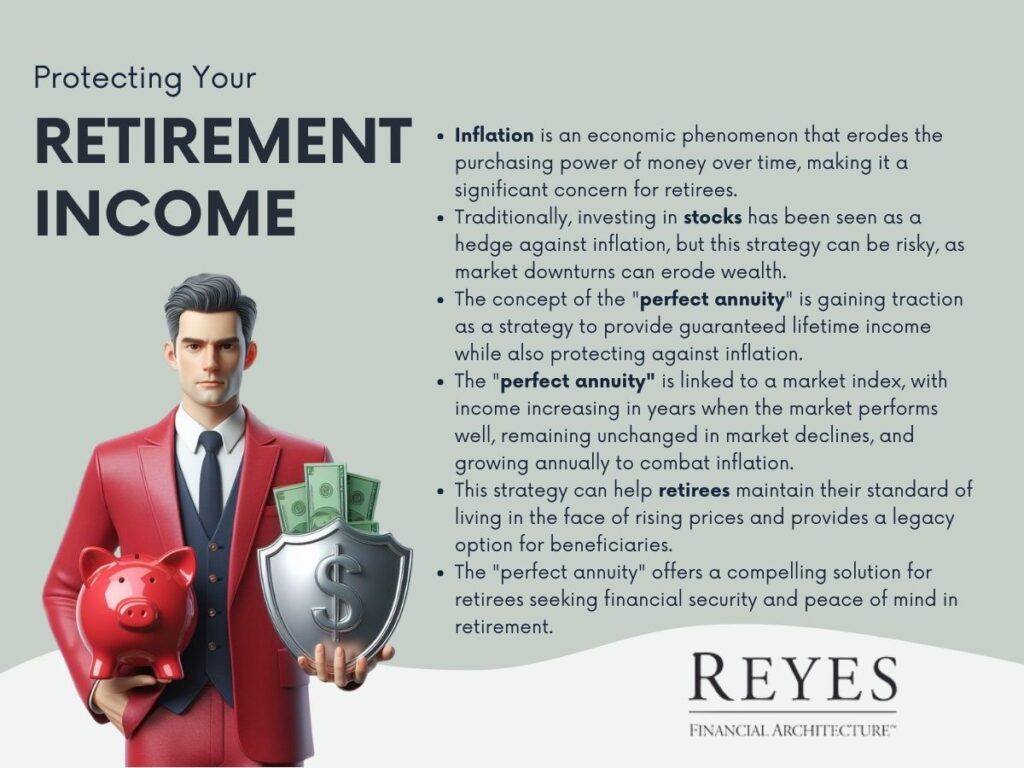
Inflation is an ever-present economic phenomenon that erodes the purchasing power of money over time. When you invest, especially in long-term assets like stocks, the goal is to outpace inflation and preserve the value of your wealth.
Traditionally, many have seen investing in stocks as a hedge against inflation, with the assumption that equities can generate returns that outpace the rising cost of living. However, this assumption doesn't always hold true, as evidenced by events like the 2008 financial crisis, which wiped out substantial portions of many portfolios.
Investors often face the challenge of ensuring that their income and wealth can withstand the corrosive effects of inflation, especially in retirement. While the concept of the "perfect annuity" may sound like an ideal solution, it remains a relatively obscure strategy. In this article, we aim to shed light on this innovative approach to safeguarding retirement income while simultaneously battling inflation.
The "perfect annuity" is a financial strategy designed to provide guaranteed lifetime income while also offering protection against inflation. This concept is gaining traction among financial advisors and retirees for its potential to address two significant retirement concerns: longevity risk and inflation risk.
Consider a scenario where an individual has a retirement portfolio of approximately $1 million. By strategically allocating a portion of this portfolio to a perfect annuity, they can secure an annual income for life. Over a 20-year period, assuming a conservative annual growth rate, their income will almost double, providing a reliable hedge against inflation.
One of the significant advantages of the perfect annuity is its resemblance to a pension. In most cases, when you choose a joint life expectancy option, both spouses can enjoy the same income benefits. Moreover, if there's a remaining balance upon the passing of the annuitant and their spouse, it can be passed on to beneficiaries, such as children, providing a legacy that many traditional annuities do not offer.
Inflation is an ever-present financial adversary, and safeguarding your retirement income against its erosive effects is paramount. The "perfect annuity" represents a powerful and relatively undiscovered tool in this battle.
By combining guaranteed lifetime income with the potential for income growth that keeps pace with inflation, this strategy offers a compelling solution for retirees seeking financial security and peace of mind.
It's a strategy worth considering as you plan for your retirement years and aim to ensure that your income not only lasts a lifetime but also remains resilient in the face of inflation's challenges.
In this article, we will explore the dynamics of the stock market and provide insights into its recent performance, potential risks, and important considerations for investors. While we often focus on various aspects of financial planning, it's crucial to address the current state of the market, especially given the unprecedented bull run we've witnessed over the past decade.
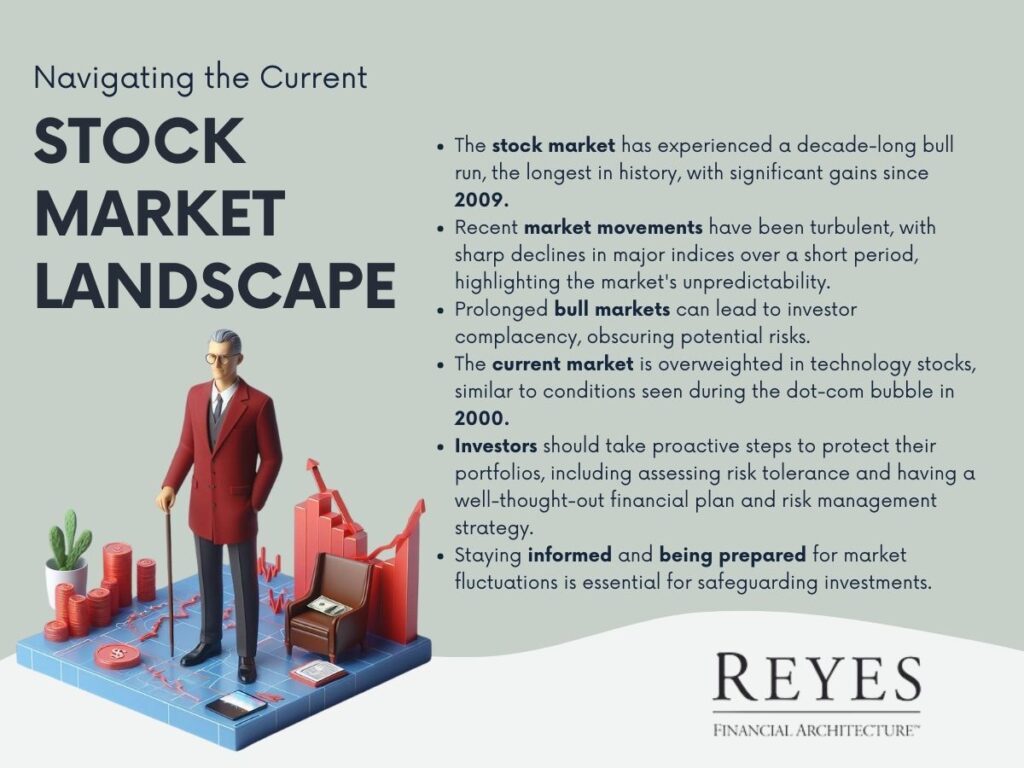
The stock market has experienced an exceptional 10-year bull run, marking its longest duration in history. Since 2009, the market has surged by more than 330%. To put it into perspective, if we were to compare this to a baseball game, we would be in extra innings.
However, the prolonged period of growth raises concerns and highlights the importance of being prepared for potential challenges ahead.
Recent market movements have been quite turbulent. For instance, in just three days in October, the Dow Jones Industrial Average experienced a sharp decline of 1,500 points, resulting in a 7% loss. The S&P 500, which had been up 9% year-to-date, saw its gains dwindle to nearly flat at just 1%. The Nasdaq also faced a 9% drop, with major tech companies like Netflix and Amazon witnessing substantial declines of 15% and 13%, respectively. These significant fluctuations occurred within a single week, emphasizing the market's unpredictability.
One of the primary concerns during a prolonged bull market is investor complacency. The more the market thrives, the more complacent investors tend to become. This complacency can be dangerous because it often obscures the potential risks that lie ahead.
As the famous adage by Warren Buffett goes, "When others are fearful, be greedy, and when others are greedy, be fearful." Currently, there seems to be a general eagerness to invest in the stock market, particularly in the tech sector.
The S&P 500 is currently overweighted by approximately 30% in technology stocks. This means that a significant portion of the S&P 500's value is attributed to technology companies. This level of overweighting in technology reminds us of the dot-com bubble in 2000, which led to an 80% decline in tech stocks.
Similarly, during the financial crisis, the S&P 500 had about 25% of its value tied to financial stocks, which subsequently lost 80%. The current overvaluation in technology stocks should not be underestimated.
Given the current market conditions and the looming risk of a downturn, it is crucial for investors to take proactive steps to protect their portfolios. While the idea of a bear market may seem alarming, it's essential to be prepared for potential losses ranging from 30% to even 50-60%. Being proactive and adequately prepared is the key to safeguarding your investments in such scenarios.
In conclusion, it is vital for investors to stay informed, assess their risk tolerance, and be ready to adapt their investment strategies in response to changing market conditions. Regardless of market circumstances, it is prudent to have a well-thought-out financial plan and risk management strategy in place. Your financial well-being is of paramount importance, and being prepared for market fluctuations is a responsible approach to safeguarding your investments.
The Little Red Book of Retirement Chapter 1
Retirement planning is a topic of paramount importance, especially for high net worth individuals. The first chapter of "The Little Red Book of Retirement" offers critical insights into the unique retirement planning needs of these individuals. This chapter lays the foundation for understanding how high net worth clients can strategically manage their wealth for a secure and fulfilling retirement.
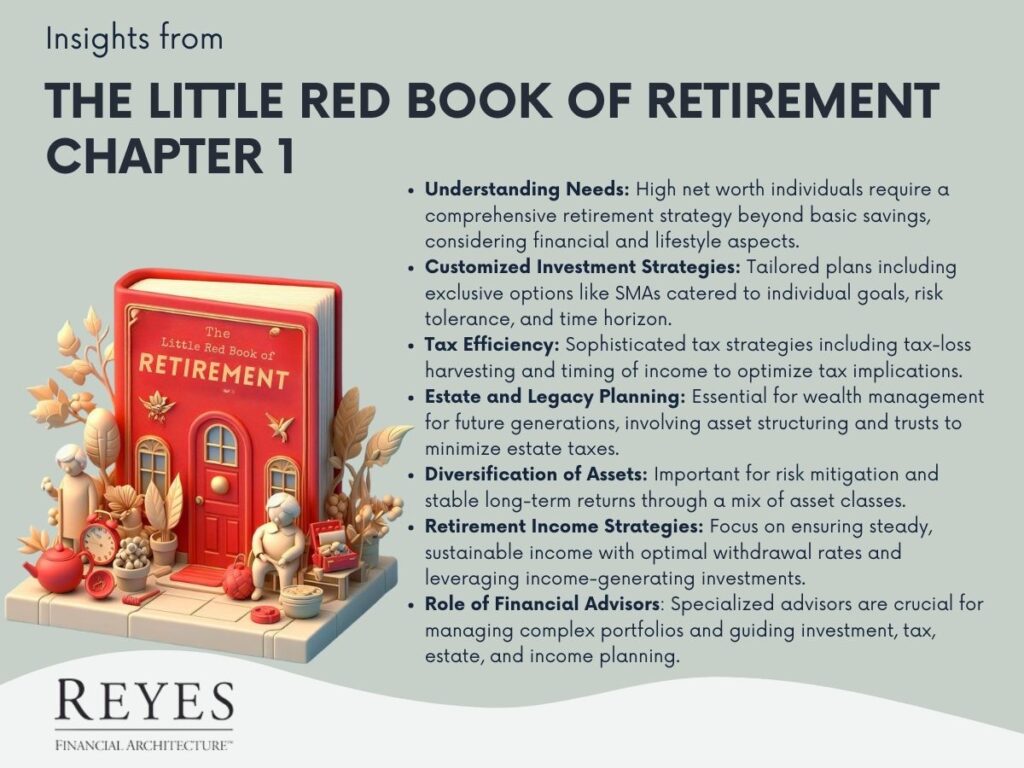
High net worth individuals, typically defined as those with a net worth exceeding $1 million, face unique challenges and opportunities in retirement planning. This chapter emphasizes that their retirement strategy needs to go beyond basic savings and investment plans. It should encompass a comprehensive approach that considers various financial and lifestyle aspects.
The first chapter of the book underscores the importance of partnering with specialized financial advisors. These professionals bring expertise in managing complex financial portfolios and can provide invaluable guidance on investment strategies, tax planning, estate management, and retirement income planning.
Chapter 1 of "The Little Red Book of Retirement" provides a comprehensive overview of the critical aspects of retirement planning for high net worth individuals. It emphasizes the need for a tailored approach that addresses the specific financial and lifestyle goals of the affluent. By understanding these key principles and working with experienced financial advisors, high net worth individuals can effectively navigate the challenges of retirement planning, ensuring financial stability and a fulfilling post-career life.
https://www.youtube.com/watch?v=8JUi3srJWs4&t=3s
Click on the link to watch the attached video to learn more about: What are RMD's and How are they Determined?
When it comes to retirement planning, understanding Required Minimum Distributions (RMDs) is crucial. Essentially, RMDs are the minimum amounts that a retirement plan account owner must withdraw annually, starting with the year they reach 70.5 years of age or, if later, the year they retire.
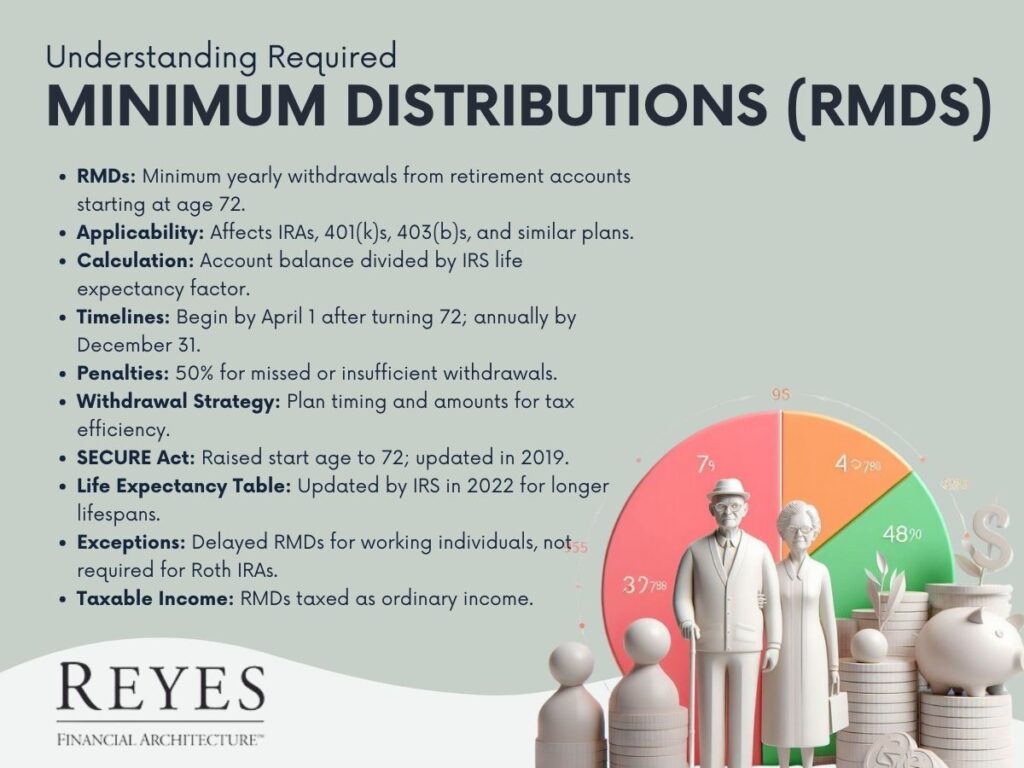
RMDs apply to tax-deferred retirement accounts. These accounts include IRAs, 401(k)s, 403(b)s, and other defined contribution plans. The rationale behind RMDs is straightforward: since contributions to these accounts are often tax-deductible, and the growth in the accounts is tax-deferred, RMDs ensure that this untaxed money is eventually subject to taxation.
The amount of an RMD is determined by dividing the account balance as of December 31 of the preceding year by a life expectancy factor set by the IRS. For example, at age 70, the life expectancy factor is 27.4 years. This means if a retiree has a retirement account balance of $100,000 at the end of the year, their RMD would be approximately $3,649 (100,000 divided by 27.4).
Understanding and planning for RMDs is a critical component of retirement planning. Failure to take an RMD, or withdrawing too little, can result in significant penalties – typically 50% of the amount that should have been withdrawn. Hence, it's essential for retirees to:
As of my last update in April 2023, there have been changes to the rules governing RMDs:
RMDs are taxable as ordinary income in the year they are withdrawn. Tax planning strategies, such as spreading out large expenses or deductions over several years, can help manage the tax burden associated with RMDs.
Required Minimum Distributions are a key aspect of retirement planning, especially for those with tax-deferred retirement accounts. Understanding how they are calculated, the timelines involved, and the strategies for managing them can have a significant impact on retirement income and taxation. With careful planning and, if necessary, professional advice, retirees can navigate RMDs effectively to optimize their retirement finances.
For a more personalized approach to RMDs and retirement strategy, consulting with a financial advisor is recommended. They can provide tailored advice and calculations based on individual circumstances, ensuring a comfortable and financially secure retirement.
Click on the link to watch our interactive video to quickly and simply understand: How to Strategize for your Social Security Benefits.
Social Security serves as a foundational element in many retirement plans, and understanding how to strategize for maximum benefits is crucial. With increasing life expectancies, retirement can last between 20 to 30 years, making Social Security planning more critical than ever. This blog explores the strategies for optimizing Social Security benefits, helping ensure a financially secure retirement.

The Social Security system in the United States is designed to provide financial support to individuals in their retirement years. The amount of benefit one receives is based on their 35 highest-earning years of work. The full retirement age (FRA) – the age at which one is eligible for full benefits – varies from 66 to 67, depending on the birth year.
The age at which you start claiming Social Security benefits significantly impacts the amount received. Claiming benefits at the earliest age of 62 results in a reduction of at least 25% compared to waiting until the full retirement age. Conversely, delaying benefits past the FRA up to age 70 leads to an increase in benefits, with a maximum increase of 32% at age 70.
For example, if the retirement income at age 66 is $2,000 per month, retiring at this age versus waiting until age 70 can mean a difference of over $200,000 over a lifetime. This stark difference underscores the importance of timing in Social Security planning.
Couples have additional strategies available. Spouses can claim benefits based on their work record or receive up to 50% of their spouse’s benefit at full retirement age, whichever is higher. Coordinating the timing of benefit claims can maximize total household Social Security income. For example, the lower-earning spouse might start benefits earlier, while the higher-earning spouse delays benefits to increase the survivor benefit.
Working while receiving Social Security benefits before reaching the full retirement age can temporarily reduce your benefits. Understanding these rules is vital for those planning to work part-time in retirement. After reaching the full retirement age, however, earnings do not affect Social Security benefits.
Up to 85% of Social Security benefits can be taxable, depending on your total income. Planning for tax implications is essential. Strategies like Roth IRA conversions or timing the withdrawal of retirement accounts can impact the taxation of Social Security benefits and overall retirement income.
Repositioning assets to reduce taxable income can lead to more tax-efficient retirement income. This might involve shifting from taxable accounts to Roth IRAs or employing tax-loss harvesting strategies. This repositioning can influence the taxation of Social Security benefits, potentially leading to lower overall tax liabilities.
With over 500 possible combinations of factors affecting benefits, consulting a financial advisor who specializes in Social Security planning is highly recommended. An advisor can offer customized strategies based on individual circumstances and help navigate the complex rules of the Social Security system.
Social Security planning should be a personalized process, reflecting individual work histories, health status, family circumstances, and retirement goals. The decision on when to claim benefits is a pivotal one, with long-lasting financial implications.
Understanding the nuances of the Social Security system and employing strategic planning can make a significant difference in retirement income, ensuring a more secure and comfortable retirement phase.
As retirements grow longer, the importance of maximizing Social Security benefits cannot be overstated. It's not just about when to start claiming benefits but how to integrate them with other retirement income sources, tax planning, and spousal benefits. Informed decisions and strategic planning in this arena are invaluable for achieving a financially stable and fulfilling retirement.